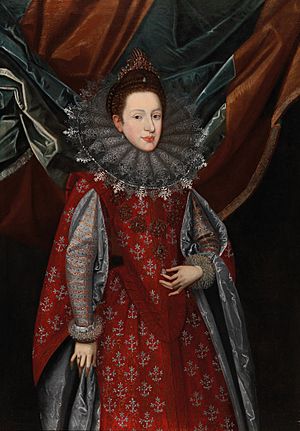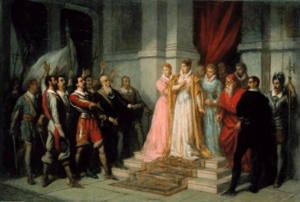Margaret of Savoy, Vicereine of Portugal facts for kids
Quick facts for kids Margaret of Savoy |
|
|---|---|

Margaret of Savoy, Duchess consort of Mantua and Montferrat (oil by Frans Pourbus)
|
|
| Duchess consort of Mantua and Montferrat | |
| Tenure | 9 February 1612 – 22 December 1612 |
| Vicereine of Portugal | |
| Tenure | 23 December 1634 – 1 December 1640 |
| Sovereign | Philip IV |
| Predecessor | Diogo de Castro |
| Born | 28 April 1589 Turin, Duchy of Savoy |
| Died | 26 June 1655 (aged 66) Miranda de Ebro, Kingdom of Spain |
| Burial | Abbey of Santa María la Real de Las Huelgas, Burgos |
| Spouse |
Francis IV, Duke of Mantua
(m. 1608; died 1612) |
| House | Savoy |
| Father | Charles Emmanuel I, Duke of Savoy |
| Mother | Catherine Micaela of Spain |
Margaret of Savoy (born April 28, 1589 – died June 26, 1655) was an important royal figure. She was the last Habsburg Vicereine of Portugal from 1634 to 1640. A "Vicereine" is like a governor who rules a country as a representative of the king. In Portugal, she was known as the Duchess of Mantua. She became the Duchess of Mantua and Montferrat when she married Francis IV. She also ruled Montferrat for her young daughter starting in 1612.
Contents
Margaret's Life and Royal Roles
Becoming a Duchess
Margaret was born in Turin, Italy, on April 28, 1589. She was the fourth child of Charles Emmanuel I, Duke of Savoy. Her mother was Infanta Catalina Micaela of Spain, who was the daughter of King Philip II of Spain.
On February 19, 1608, Margaret married Francis IV. He was the future Duke of Mantua and Montferrat. Their wedding took place in Turin. In 1612, Francis became the Duke of Mantua after his father, Vincent I, passed away.
Margaret and Francis had three children together. Sadly, only one daughter, Maria, lived past childhood. Francis died in 1612, leaving Margaret a widow.
Ruling Montferrat
Since Margaret and Francis had no sons who survived, Francis's brother became the next Duke of Mantua. However, the Duchy of Montferrat had different rules. It could be inherited by females. So, Francis's three-year-old daughter, Maria, became the Duchess of Montferrat.
Because Maria was so young, her mother, Margaret, became her regent. A regent is someone who rules for a child until they are old enough to rule themselves. This inheritance was not easy. Maria was a child for the next ten years. Eventually, Francis's brothers did not have any children who could inherit the duchy. This led to a big conflict called the Mantuan War of Succession (1627–1632).
To help solve the problem, Margaret's daughter Maria married Charles of Gonzaga-Nevers in 1627. He was related to the Gonzaga family, who also had a claim to the duchies. They had to fight a war, but in the end, their family line won. They were recognized as the rightful Dukes of Mantua and Montferrat.
Serving as Vicereine of Portugal
Margaret had family connections to Portugal. Two of her great-grandmothers were daughters of King Manuel I of Portugal. This made her a good choice for a special role.
Since 1580, the kingdoms of Portugal and Spain had been ruled together by the Spanish king. This was called the Iberian Union. The Spanish king promised that Portugal would still have some local rule through a viceroy. This viceroy was supposed to have ties to Portugal or the Spanish royal family.

In 1635, King Philip IV of Spain, who was Margaret's cousin, chose her to be the Vicereine of Portugal. She moved to Portugal in 1636. This decision was influenced by people close to the king who believed Margaret was a good fit.
However, in 1640, the Portuguese people started a revolution. They wanted their independence back from Spain. This event is known as the Restoration of Independence. During this time, a key official was killed. Margaret tried to calm the people during protests in Lisbon's main square. But the Portuguese declared the Duke of Braganza as their new king. Margaret was surrounded in her headquarters in Lisbon. With her support gone, the new king allowed her to leave for Spain.
Margaret passed away in Miranda de Ebro, Spain, in 1655. Her daughter, Duchess Maria, outlived her. Margaret also had two grandchildren. Her granddaughter, Eleanor, became the Holy Roman Empress in 1651. Her grandson, Charles, became the Duke of Mantua in 1637. By the time Margaret died, both her grandchildren had already had their own children, giving her great-grandchildren.
Margaret's Children
Margaret had three children:
- Maria (July 29, 1609 – August 14, 1660); she married Charles II Gonzaga, duke of Nevers, in 1627.
- Ludovico (April 21, 1611 – August 3, 1612).
- Eleonora (September 12, 1612 – September 13, 1612).
See also
 In Spanish: Margarita de Saboya para niños
In Spanish: Margarita de Saboya para niños

